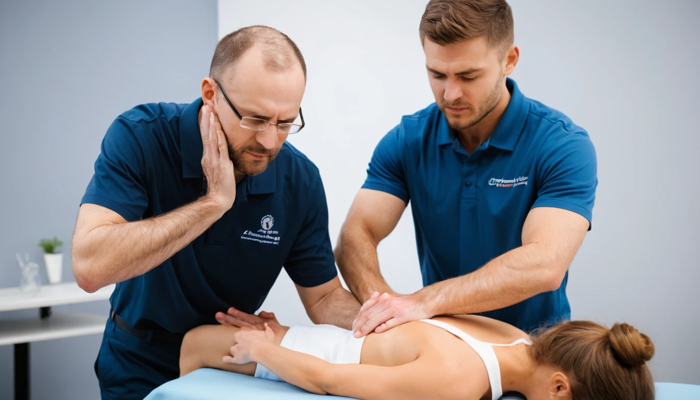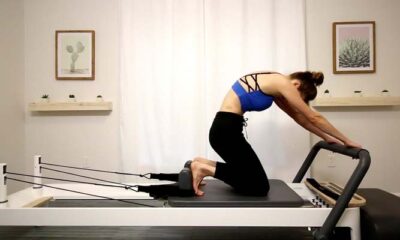Healthcare Systems
What Does A Chiropractor Do? Understanding Care And Healing

What Does A Chiropractor Do? Learn how chiropractic care eases pain, restores motion, and boosts daily function with gentle, natural treatments.
A chiropractor treats musculoskeletal issues with hands-on adjustments and rehab. They ease pain, restore movement, and give exercise and lifestyle advice for lasting recovery and better posture.
What Does A Chiropractor Do?
Ever Wonder If Popping A Back Can Really Help Your Pain Or Posture?
Yes — a chiropractor does more than push on your spine. They diagnose, treat, and coach you toward better movement. Think of them as movement specialists who use hands-on care, exercise, and simple lifestyle fixes to help your body work better.
How Chiropractic Care Works 🩺
Chiropractic care focuses on the spine and joints. The goal is to restore normal motion. When joints move well, nerves and muscles work better. That helps reduce pain and improve function.
Chiropractors use hands-on skills and gentle tools. They combine adjustments with exercises and advice. Care is often short-term and goal-focused. The plan aims to get you moving and keep you moving. 😊
NYC chiropractors provide expert care to relieve back, neck, and joint pain naturally. They focus on safe, hands-on adjustments. Many patients experience lasting pain relief and improved posture after consistent treatments.
Common Treatments And Techniques 💆
Adjustments, or spinal manipulations, are core techniques. These use a quick, controlled thrust to free up a joint. Mobilization is gentler and uses slow motion. Both aim to improve joint mobility.
Therapists also use soft-tissue work like massage and trigger release. They may use dry needling, electrical stimulation, or traction. Treatment mixes depend on your pain and goals. The plan is tailored and practical.
Spinal Adjustments: What Happens 🔧
An adjustment is a targeted push to a joint. It can make a popping sound, which is normal. That sound is from gas releasing in the joint. The key is restored movement and less pain.
Adjustments vary by style and force. Some are low-force and instrument-based. Others are hands-on thrusts that feel brisk. Your chiropractor will choose the safest option for you. 👍
Diagnosing Your Problem 🧭
A chiropractor starts with a thorough history. They ask about pain, injuries, and daily habits. Next comes a physical exam of movement and posture. Tests may include strength and nerve checks.
Imaging like X-rays or MRI might be recommended. These help rule out red flags or severe disease. Diagnosis drives the care plan and the expected timeline. Clear goals are set from day one.
Conditions Chiropractors Treat 🦴
Chiropractors often treat back and neck pain. They also help with sciatica and headaches. Many patients come for posture and joint pain too. Sports injuries and repetitive strain are common.
Chiropractic care may help shoulder and knee issues. It can also support recovery after minor car accidents. Results vary with the condition and timing of care. Early care often speeds recovery.
| Condition | Typical Goal | Common Technique |
| Low Back Pain | Pain Relief & Mobility | Spinal Adjustment |
| Neck Pain | Reduce Stiffness | Mobilization & Exercises |
| Sciatica | Reduce Nerve Irritation | Traction & Rehab |
Benefits Of Chiropractic Care 🤸♀️
Chiropractic care can reduce pain fast. It often improves range of motion and posture. Many people report better sleep and easier daily tasks. It also offers drug-free symptom relief.
Care includes exercise and lifestyle steps. That helps prevent the problem from coming back. Some people combine care with physical therapy. Together, these approaches speed long-term healing. 🌟
Side Effects And Safety Considerations ⚠️
Most side effects are mild and short-lived. You may feel sore or tired after a visit. Serious complications are rare in healthy people. Tell your chiropractor about any medical conditions.
Chiropractic is not for every condition. People with certain fractures or severe osteoporosis need caution. Your clinician will screen for risks first. Safety comes from proper assessment and gentle technique.
Chiropractor vs Physical Therapist 🆚
Both treat movement problems and pain. Chiropractors focus on spine and joint adjustments. Physical therapists focus on exercise-based rehabilitation. Both use hands-on care and active rehab.
Choosing depends on your needs and preferences. For spine-specific adjustments, see a chiropractor. For complex rehab after surgery, a physical therapist may fit better. Many patients see both for full recovery.
What To Expect In A First Visit 📋
Expect questions about your health and pain. The exam checks posture, range of motion, and nerves. Your chiropractor may perform simple functional tests. This helps identify the root cause.
You will get a clear treatment plan and goals. The first visit often includes a gentle adjustment or technique. You may receive simple home exercises to try. Follow-up visits monitor progress and tweak care.
How Often Should You See A Chiropractor? ⏱️
Frequency depends on pain severity and goals. Acute pain may need visits 1–3 times weekly. As you improve, visits reduce and focus on maintenance. The goal is independence through exercise.
Some people do periodic check-ins for posture or sport performance. Others stop when pain clears. Your chiropractor will make a schedule that fits your life. The plan balances results and cost.
| Phase Of Care | Typical Visits | Goal |
| Acute | 1–3x Weekly | Reduce Pain |
| Recovery | Weekly | Build Strength |
| Maintenance | Monthly or PRN | Prevent Relapse |
Chiropractic For Seniors 👵
Seniors can benefit from gentle chiropractic care. Low-force techniques reduce strain on bones. Care focuses on mobility, balance, and fall prevention. Exercises help maintain independence.
Screening for osteoporosis and medications is important. Treatment often combines rehab and ergonomic fixes. Seniors report better function and less pain. Care is tailored to age and health status. 💪
Chiropractic For Sports Injuries 🏃♂️
Athletes use chiropractic care for performance and recovery. Adjustments can improve joint motion and range. Rehab strengthens weak muscles and corrects imbalances. Care helps prevent recurrent injuries.
On-field care may include quick assessments and taping. Long-term plans add sport-specific drills. Many athletes see improved speed and less injury downtime. Teamwork with coaches boosts results. ⚽️
At-Home Care And Exercises 🏠
You will learn simple stretches and strength moves. These exercises speed recovery and prevent relapse. Your chiropractor shows progressions and safety tips. Home work is a big part of success.
Ergonomic tweaks for work and sleep help too. Small changes can cut load on the spine. Think posture, chair height, and pillow choice. These steps support long-term healing. 😊
| Exercise | Purpose | How Often |
| Cat-Cow Stretch | Improve Spine Flexibility | Daily, 1–2 Sets |
| Glute Bridges | Strengthen Hips | 3x Weekly |
| Neck Retracts | Improve Posture | Daily, 10 Reps |
Insurance, Costs, And Accessibility 💳
Insurance often covers chiropractic visits. Coverage varies by plan and region. Ask your insurer about limits and co-pays. Many clinics offer cash rates and packages.
Costs depend on location and services used. A single visit can range widely across clinics. Check if X-rays or therapies add costs. Transparency from your provider helps plan care.
How To Choose A Good Chiropractor ✅
Seek licensed chiropractors with patient reviews. Ask about their experience with your condition. Look for clear communication and a plan you understand. Trust and comfort matter a lot.
Good chiropractors track progress and adjust treatment. They refer out when needed. Ask about techniques and expected outcomes. A short trial of care often shows results.
- Check credentials and license.
- Read reviews and ask friends.
- Ask about techniques and success rates.
Myths And Misconceptions 🔍
A common myth is that chiropractic care is unsafe. In reality, it is safe when done right. Many studies support its role for back and neck pain. Like any care, quality and screening matter.
Another myth says chiropractors only “crack” backs. They offer exercise, education, and rehab too. Care is multi-layered and patient-centered. Think of it as movement care, not just popping sounds. ✨
“Chiropractic Isn’t Just Popping. It’s About Movement, Strength, And Daily Habits.” 😊
When To See A Chiropractor Immediately 🚨
See a chiropractor quickly for sudden, severe spine pain. Also seek urgent care after car accidents. Nerve symptoms like weakness or bowel changes need fast attention. If in doubt, get assessed to rule out red flags.
Chiropractors will refer to emergency care when needed. They are trained to spot dangerous signs. Never delay care for severe symptoms. Timely action improves outcomes.
Final Thoughts And Next Steps 🔁
Chiropractors treat joint and spine problems with hands-on care. They combine adjustments, rehab, and lifestyle steps for lasting gains. Most people find reduced pain and better function. Try a short course and track your progress.
If you are unsure, ask questions on the first visit. Look for clear goals and shared decision-making. With the right provider, chiropractic care can be safe and effective. ✅😊
Key Takeaways
- Chiropractors focus on joint mobility and pain relief.
- Care mixes adjustments, exercise, and lifestyle coaching.
- Safety comes from screening and choosing the right provider.
FAQs
How Does Chiropractic Care Work?
Chiropractors assess movement and posture. They use adjustments and rehab to restore function. Care includes exercises and lifestyle advice.
Can A Chiropractor Fix Back Pain?
Many people get significant back pain relief. Results depend on the cause and timing. Early care often gives faster improvement.
Is Chiropractic Safe For Seniors?
Yes, when tailored to age and health. Low-force techniques reduce risk. Seniors benefit from mobility and balance work.
How Often Should I See A Chiropractor?
Frequency depends on pain level and goals. Acute pain may need multiple weekly visits. Then care tapers to maintenance.
What Happens During An Adjustment?
A targeted thrust or gentle move frees a joint. You may hear a pop; it is normal. The goal is better motion and less pain.
-

 Healthcare Systems5 years ago
Healthcare Systems5 years agoDifferent Types of Healthcare Systems
-

 Fitness5 years ago
Fitness5 years agoPilates Reformer Compared to the Tower: Which Should You Choose?
-

 Healthy Living7 years ago
Healthy Living7 years ago14 Coffee Substitutes That Will Help Keep You Awake & Energized
-
Healthcare Systems5 years ago
How Administrative Tasks Adversely Affect Physicians And Patients





